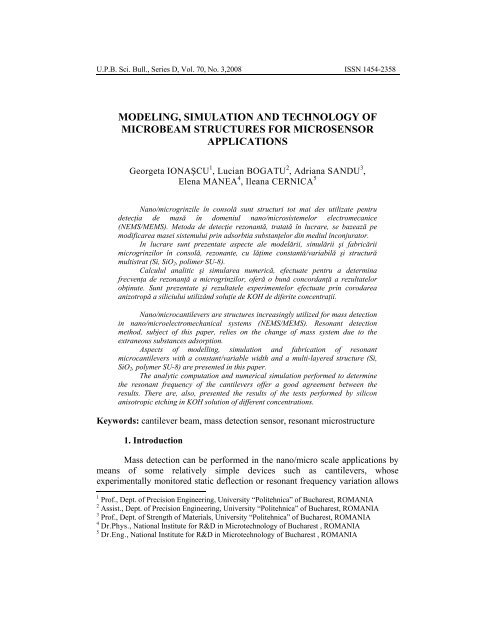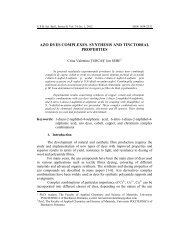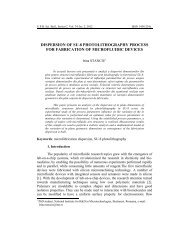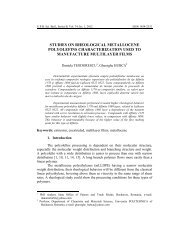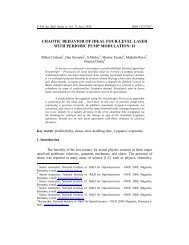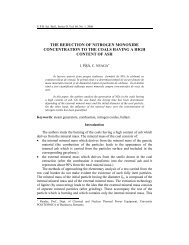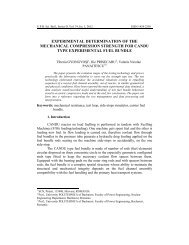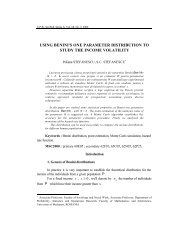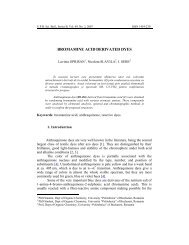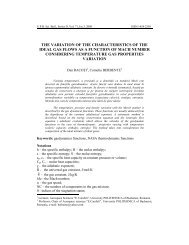modeling, simulation and technology of ... - Scientific Bulletin
modeling, simulation and technology of ... - Scientific Bulletin
modeling, simulation and technology of ... - Scientific Bulletin
Create successful ePaper yourself
Turn your PDF publications into a flip-book with our unique Google optimized e-Paper software.
U.P.B. Sci. Bull., Series D, Vol. 70, No. 3,2008 ISSN 1454-2358<br />
MODELING, SIMULATION AND TECHNOLOGY OF<br />
MICROBEAM STRUCTURES FOR MICROSENSOR<br />
APPLICATIONS<br />
Georgeta IONAŞCU 1 , Lucian BOGATU 2 , Adriana SANDU 3 ,<br />
Elena MANEA 4 , Ileana CERNICA 5<br />
Nano/microgrinzile în consolă sunt structuri tot mai des utilizate pentru<br />
detecţia de masă în domeniul nano/microsistemelor electromecanice<br />
(NEMS/MEMS). Metoda de detecţie rezonantă, tratată în lucrare, se bazează pe<br />
modificarea masei sistemului prin adsorbtia substanţelor din mediul înconjurator.<br />
In lucrare sunt prezentate aspecte ale modelării, simulării şi fabricării<br />
microgrinzilor în consolă, rezonante, cu lăţime constantă/variabilă şi structură<br />
multistrat (Si, SiO 2 , polimer SU-8).<br />
Calculul analitic şi simularea numerică, efectuate pentru a determina<br />
frecvenţa de rezonanţă a microgrinzilor, <strong>of</strong>eră o bună concordanţă a rezultatelor<br />
obţinute. Sunt prezentate şi rezultatele experimentelor efectuate prin corodarea<br />
anizotropă a siliciului utilizând soluţie de KOH de diferite concentraţii.<br />
Nano/microcantilevers are structures increasingly utilized for mass detection<br />
in nano/microelectromechanical systems (NEMS/MEMS). Resonant detection<br />
method, subject <strong>of</strong> this paper, relies on the change <strong>of</strong> mass system due to the<br />
extraneous substances adsorption.<br />
Aspects <strong>of</strong> modelling, <strong>simulation</strong> <strong>and</strong> fabrication <strong>of</strong> resonant<br />
microcantilevers with a constant/variable width <strong>and</strong> a multi-layered structure (Si,<br />
SiO 2 , polymer SU-8) are presented in this paper.<br />
The analytic computation <strong>and</strong> numerical <strong>simulation</strong> performed to determine<br />
the resonant frequency <strong>of</strong> the cantilevers <strong>of</strong>fer a good agreement between the<br />
results. There are, also, presented the results <strong>of</strong> the tests performed by silicon<br />
anisotropic etching in KOH solution <strong>of</strong> different concentrations.<br />
Keywords: cantilever beam, mass detection sensor, resonant microstructure<br />
1. Introduction<br />
Mass detection can be performed in the nano/micro scale applications by<br />
means <strong>of</strong> some relatively simple devices such as cantilevers, whose<br />
experimentally monitored static deflection or resonant frequency variation allows<br />
1 Pr<strong>of</strong>., Dept. <strong>of</strong> Precision Engineering, University “Politehnica” <strong>of</strong> Bucharest, ROMANIA<br />
2 Assist., Dept. <strong>of</strong> Precision Engineering, University “Politehnica” <strong>of</strong> Bucharest, ROMANIA<br />
3 Pr<strong>of</strong>., Dept. <strong>of</strong> Strength <strong>of</strong> Materials, University “Politehnica” <strong>of</strong> Bucharest, ROMANIA<br />
4 Dr.Phys., National Institute for R&D in Micro<strong>technology</strong> <strong>of</strong> Bucharest , ROMANIA<br />
5 Dr.Eng., National Institute for R&D in Micro<strong>technology</strong> <strong>of</strong> Bucharest , ROMANIA
20<br />
Georgeta Ionascu, Lucian Bogatu, Adriana S<strong>and</strong>u, Elena Manea, Ileana Cernica<br />
a quantitative assessment <strong>of</strong> the mass attached to these devices [1]. Static<br />
deflection methods are based on the fact that the adsorbed (substance) mass<br />
induces a stress gradient into the structure, which causes deformations<br />
(deflections) <strong>of</strong> the beam. The mass being attached, either localized in a point or<br />
disposed on a surface in a layer form, can be considered as a gravity force that<br />
acts on a beam <strong>and</strong> generates deflections. Resonant detection methods rely on the<br />
change <strong>of</strong> the sensing system mass (by attachment <strong>of</strong> extraneous matter) or on the<br />
combined modification <strong>of</strong> mass <strong>and</strong> rigidity (as the case is <strong>of</strong> a layer – like<br />
deposition), which produces a variation in the fundamental resonant frequency<br />
(usually bending or torsion).<br />
Minimal amounts <strong>of</strong> the deposited mass <strong>of</strong> femptograms (10 -15 grams) <strong>and</strong><br />
even attograms (10 -18 grams) have already been detected <strong>and</strong> the promise <strong>of</strong><br />
downscaling by three orders <strong>of</strong> magnitude, which is equivalent to molecule-level<br />
detection, can only be achieved by very small size devices.<br />
Nano/micro mass detectors are implemented as sensors in a variety <strong>of</strong><br />
applications such as chemical, biological or clinical analyses, environmental<br />
control, monitoring <strong>of</strong> industrial applications by study <strong>of</strong> variations in<br />
temperature, viscosity, mass, stress or electric/magnetic fields [2]. The initial<br />
structure is coated with a (polymer) layer that will retain the substance <strong>of</strong> interest<br />
generally by chemical reactions. This deposition process is followed by mass<br />
addition. The difference between the significant variable values (deflection in<br />
static methods <strong>and</strong> frequency change in resonant methods) determined before <strong>and</strong><br />
after mass retaining constitutes the measure for evaluating the quantity <strong>of</strong> attached<br />
mass.<br />
This paper studies the mass detection by means <strong>of</strong> the resonant frequency<br />
variation method, considering two configurations:<br />
- a microcantilever beam <strong>of</strong> constant width;<br />
- a microcantilever beam <strong>of</strong> variable width (paddle cantilever).<br />
The obtaining <strong>technology</strong> <strong>and</strong> experimental results for their execution by<br />
silicon anisotropic wet etching are presented too.<br />
2. Analytic computation<br />
The fundamental frequency for an homogeneous <strong>and</strong> prismatic cantilever<br />
beam <strong>of</strong> mass m, loaded at an end with a concentrated mass M (fig. 1), can be<br />
approximately computed by the Rayleigh method [3, 4]:<br />
1 3EI<br />
1 3EI<br />
f = =<br />
(1)<br />
2π 3<br />
( 0,23 ) 2 3<br />
l M + m π l ( M + 0,23ρAl)<br />
The following notations were used:<br />
EI – the bending stiffness,
Modeling, <strong>simulation</strong> <strong>and</strong> <strong>technology</strong> <strong>of</strong> microbeam structures for microsensor applications 21<br />
M – the attached mass: M = M polymer + M gas (the polymer is localized in a<br />
point <strong>and</strong> adsorbs selectively a certain gas),<br />
l – the length, A – the cross-sectional area <strong>of</strong> the beam <strong>and</strong> ρ – the density<br />
<strong>of</strong> the beam material.<br />
Fig. 1. Model <strong>of</strong> analytic computation<br />
If the attached mass, M, is absent (M = 0), the resonant frequency<br />
corresponding to the first vibration mode for a cantilever beam results:<br />
1 3EI<br />
3.61 EI<br />
f0<br />
= ≅<br />
(2)<br />
2π 4 2<br />
0,23ρAl<br />
2π<br />
l ρA<br />
The analysed microcantilever beams are processed by micr<strong>of</strong>abrication<br />
technologies specific to the microsensors: the silicon anisotropic wet etching is<br />
used to release the microbeam from the silicon substrate (wafer), which acts as a<br />
sacrificial material. A boron doped surface layer <strong>of</strong> silicon works as an etch stop<br />
layer. So, the under study microcantilevers, figures 2 <strong>and</strong> 3, are consequently<br />
multilayered structures, with a non-homogeneous (composite) sectional area, the<br />
layers succession being given in fig. 4: silicon, silicon dioxide <strong>and</strong> polymer<br />
(SU-8, which is a photoresist layer, too, used in the photolithographic process).<br />
y<br />
b<br />
x<br />
l<br />
Fig. 2. Microcantilever beam <strong>of</strong> constant width<br />
y<br />
b 1<br />
b 2<br />
x<br />
l 1<br />
l 2<br />
Fig. 3. Microcantilever beam <strong>of</strong> variable width
22<br />
Georgeta Ionascu, Lucian Bogatu, Adriana S<strong>and</strong>u, Elena Manea, Ileana Cernica<br />
z<br />
x<br />
z G<br />
t 1<br />
(Si) t 2<br />
(SiO 2<br />
) t 3<br />
(polymer)<br />
Fig. 4. Succession <strong>of</strong> layers that compose the microcantilevers;<br />
the centroidal axis <strong>of</strong> the composite beam is marked<br />
In this case, the bending stiffness EI <strong>and</strong> density ρ are replaced in<br />
equations 1 <strong>and</strong> 2 with the composite bending stiffness EI <strong>and</strong> composite<br />
density ρ :<br />
N<br />
EI = ∑ E i I i<br />
i=<br />
1<br />
N<br />
∑ ρiti<br />
i=<br />
1<br />
ρ = N<br />
∑ ti<br />
i=<br />
1<br />
where: N – the number <strong>of</strong> layers in the composite cantilever, E i I i - the bending<br />
stiffness <strong>of</strong> the individual layers, ρ i – the density <strong>of</strong> the individual layers, t i – the<br />
thickness <strong>of</strong> the individual layers.<br />
The centroid coordinate (the location z G <strong>of</strong> the neutral plane) <strong>of</strong> the<br />
composite beam is found by:<br />
∑<br />
∑<br />
z G =<br />
Ei<br />
Ai<br />
zi<br />
Ei<br />
Ai<br />
(5)<br />
where<br />
t i<br />
= + ∑ − 1<br />
z i<br />
i<br />
t<br />
2 k=<br />
1 k<br />
(6)<br />
A i = bech<br />
ti<br />
(7)<br />
b1 l1<br />
+ b2l<br />
b 2<br />
ech =<br />
l1<br />
+ l2<br />
(8)<br />
b ech – is an equivalent width <strong>of</strong> a microbeam <strong>of</strong> constant width <strong>and</strong> mass<br />
equal to that one <strong>of</strong> the microcantilever <strong>of</strong> variable width (obviously, b ech = b for<br />
the microcantilever <strong>of</strong> constant width).<br />
A i – is the cross-sectional area <strong>of</strong> each individual layer.<br />
The individual moments <strong>of</strong> inertia I i <strong>of</strong> each layer are computed with the<br />
following equation:<br />
(3)<br />
(4)
Modeling, <strong>simulation</strong> <strong>and</strong> <strong>technology</strong> <strong>of</strong> microbeam structures for microsensor applications 23<br />
Ii<br />
3<br />
bech<br />
ti<br />
2<br />
+ bech<br />
ti<br />
( zG<br />
− zi<br />
)<br />
12<br />
= (9)<br />
Replacing EI <strong>and</strong> ρ in equations (1) <strong>and</strong> (2), the fundamental resonant<br />
frequency <strong>of</strong> the composite cantilever beam <strong>and</strong> its variation after the gas sorption<br />
into the polymer layer are obtained:<br />
1<br />
f1<br />
= f<br />
(10)<br />
0<br />
M<br />
1+<br />
0,23ρAl<br />
⎛<br />
⎞<br />
⎜ 1<br />
Δf<br />
= f − f = f 1−<br />
⎟<br />
(11)<br />
0 1 0⎜<br />
⎟<br />
⎝ 1+<br />
K m ⎠<br />
where K m is a non-dimensional coefficient (the mass fraction), determined<br />
according to the composite cantilever beam mass <strong>and</strong> the attached mass.<br />
M<br />
K m = (12)<br />
0,23ρAl<br />
The microsensor sensitivity S, which represents the frequency variation<br />
per unit <strong>of</strong> added mass by adsorption, can be calculated as:<br />
Δf<br />
S = (13)<br />
ΔM<br />
This equation indicates that in order to obtain a high sensitivity the<br />
structure must be sized so that its resonant frequency be high <strong>and</strong> its equivalent<br />
mass (m e = ρ A l) be small. The minimum mass quantity ΔM min , which can<br />
experimentally be detected through a minimum resonant frequency variation Δf min ,<br />
can be estimated as:<br />
Δfmin<br />
( 2 f0<br />
− Δf<br />
min )<br />
( Δ M ) min =<br />
m<br />
2<br />
e<br />
(14)<br />
f0<br />
3. Numerical <strong>simulation</strong><br />
To optimize the structure geometry in order to obtain a sensitivity as high<br />
as possible, parametric models have been performed for both constructive<br />
versions presented in figures 2, 3 <strong>and</strong> 4. Varying one <strong>of</strong> the parameters <strong>and</strong><br />
keeping constant the other ones, an analysis <strong>of</strong> sensitivity can be made. The<br />
computations were made considering the following initial data:<br />
- for the microcantilever beam <strong>of</strong> constant width: b = 80 μm; l = 300 μm;<br />
- for the microcantilever beam <strong>of</strong> variable width: b 1 = 60 μm; b 2 = 70 μm;<br />
l 1 = 150 μm; l 2 = 150 μm.<br />
For both <strong>of</strong> them: t 1 (doped Si layer) = 10 μm; t 2 (SiO 2 layer) = 1.7 μm;<br />
t 3 (SU-8 layer) = 4 μm. The considered values <strong>of</strong> elastic <strong>and</strong> physical constants <strong>of</strong><br />
the layer materials are given in table 1.
24<br />
Georgeta Ionascu, Lucian Bogatu, Adriana S<strong>and</strong>u, Elena Manea, Ileana Cernica<br />
Material properties <strong>of</strong> the layers, which form the composite cantilever beams<br />
Material E [GPa] ν ρ [kg/m 3 ]<br />
Silicon 165 0.17 2330<br />
SiO 2 70 0.17 2200<br />
Polymer (SU-8) 4.4 0.22 1200<br />
Table 1<br />
Fig. 5. The first three vibration modes - microcantilever beam <strong>of</strong> constant width (the first two<br />
bending modes <strong>and</strong> the first torsion mode)<br />
The polymer which adsorbs the gas can be taken in calculation either as a<br />
layer deposited on the entire surface <strong>of</strong> the microbeam (such as we have<br />
considered it) or as a mass particle localized in a point-like manner on the
Modeling, <strong>simulation</strong> <strong>and</strong> <strong>technology</strong> <strong>of</strong> microbeam structures for microsensor applications 25<br />
longitudinal direction (symmetrical axis) <strong>of</strong> the microbeam. The structure<br />
meshing was made in elements <strong>of</strong> three-dimensional solid. Because <strong>of</strong> the<br />
dimensions extremely small <strong>of</strong> the structures, a convenient choice <strong>of</strong> the tolerance<br />
was made, both for the microstructure geometry description <strong>and</strong> for its meshing<br />
(TOL = 10 -8 ÷10 -9 ). The first three vibration modes for both versions <strong>of</strong> beams are<br />
given in figures 5 <strong>and</strong> 6.<br />
Fig. 6. The first three vibration modes-microcantilever beam <strong>of</strong> variable width
26<br />
Georgeta Ionascu, Lucian Bogatu, Adriana S<strong>and</strong>u, Elena Manea, Ileana Cernica<br />
One can see that the fundamental frequencies are <strong>of</strong> hundreds <strong>of</strong> kHz<br />
order: 121.6 kHz for the microcantilever beam <strong>of</strong> constant width <strong>and</strong> 107.4 kHz<br />
for the microcantilever beam <strong>of</strong> variable width.<br />
Fig. 7. Comparison between the obtained results analytically <strong>and</strong> numerically<br />
Fig. 7 presents a comparison between values <strong>of</strong> the first fundamental<br />
resonant frequency for the microcantilever beam <strong>of</strong> constant width, obtained by<br />
using both analytic <strong>and</strong> numerical computation. As was expected, there is a good<br />
agreement between these values for ratios l/b > 3.5. For l/b < 3.5, the microbeam<br />
becomes a "microplate", therefore the bar theory cannot be used.<br />
4. Experimental results<br />
Cantilever<br />
beam<br />
(111)<br />
Side view<br />
SiO 2<br />
h<br />
Si<br />
54.74 o<br />
(100) Surface<br />
orientation<br />
l<br />
Top view<br />
L<br />
b<br />
a<br />
Concave<br />
Convex<br />
corner<br />
corner<br />
Fig. 8. A pyramidal pit etched in (100) silicon, with an undercut cantilever beam<br />
(a = 200 μm, b = 80 μm, L = 500 μm, l = 300 μm, h = 30 μm)
Modeling, <strong>simulation</strong> <strong>and</strong> <strong>technology</strong> <strong>of</strong> microbeam structures for microsensor applications 27<br />
Most liquid-phase etches can be modulated by added dopants in the silicon<br />
(boron, in our case), as well as electrochemical biasing, but slow down at the<br />
(111) planes regardless <strong>of</strong> the dopant. It is important to note that from the top<br />
view, etching at "concave" corners on (100) silicon stops at (111) intersections,<br />
but "convex" corners are undercut, allowing cantilevers rapidly undercut <strong>and</strong><br />
release. This is illustrated in fig. 8.<br />
90<br />
80<br />
(100) Si<br />
Etch rate (mm/h)<br />
70<br />
60<br />
50<br />
40<br />
30<br />
20<br />
80 o C<br />
10<br />
60 o C<br />
0<br />
0 10 20 30 40 50 60<br />
KOH (%)<br />
Fig. 9. The etch rate <strong>of</strong> (100) Si vs. the KOH solution concentration at 60°C <strong>and</strong> 80°C<br />
500<br />
450<br />
400<br />
350<br />
80 o C<br />
SiO 2<br />
Etch rate (nm/h)<br />
300<br />
250<br />
200<br />
150<br />
100<br />
50<br />
60 o C<br />
0<br />
0 10 20 30 40 50 60<br />
KOH (%)<br />
Fig. 10. The etch rate <strong>of</strong> SiO 2 vs. the KOH solution concentration at 60°C <strong>and</strong> 80°C
28<br />
Georgeta Ionascu, Lucian Bogatu, Adriana S<strong>and</strong>u, Elena Manea, Ileana Cernica<br />
a) b)<br />
c) d)<br />
Fig. 11. Aspects <strong>of</strong> microbeams executed in (100) Si covered with a protective SiO 2 layer before<br />
etching (a), <strong>and</strong> after an anisotropic wet etch (50% KOH, 80°C) in a time <strong>of</strong> 30 minutes (b), 60<br />
minutes (c) <strong>and</strong> 90 minutes (d)<br />
More experiments were made in order to determine the etch rates <strong>of</strong> (100)<br />
Si in KOH solution <strong>of</strong> different concentrations. (100) silicon wafers <strong>of</strong> p <strong>and</strong> n-<br />
type <strong>and</strong> (111) silicon wafers were used. They were covered with a SiO 2 layer,<br />
thermally grown (∼1.7÷1.9 μm, oxide thickness) at 1100°C in water vapors<br />
(∼7 hours). The SiO 2 layer is, at the same time, a structural layer <strong>and</strong> a masking
Modeling, <strong>simulation</strong> <strong>and</strong> <strong>technology</strong> <strong>of</strong> microbeam structures for microsensor applications 29<br />
layer. Its etch was performed in a NH 4 F:HF solution with a volumetric ratio <strong>of</strong><br />
7:1, at 25°C.<br />
We have made dimensional measurements <strong>of</strong> the depth <strong>of</strong> the obtained<br />
cavities. The measurements were performed comparatively using a<br />
micropr<strong>of</strong>ilometer (α-step) <strong>and</strong> an optical microscope. The roughness values<br />
<strong>of</strong> the etched surfaces were measured with the Tencor P-1 instrument.<br />
The etch rate <strong>and</strong> the anisotropy parameters are influenced by the<br />
KOH solution concentration, temperature <strong>and</strong> isopropylic alcohol (IPA)<br />
addition. The IPA addition modifies the surface tension <strong>of</strong> the solution <strong>and</strong><br />
lightens the release <strong>of</strong> the hydrogen bubbles from the silicon surface.<br />
The etch rate presents a maximum for a KOH solution concentration<br />
between 15÷20% <strong>and</strong> diminishes continuously at higher concentrations,<br />
fig. 9. The KOH solution can be used between the ambient temperature <strong>and</strong><br />
the boiling point without forming <strong>of</strong> insoluble reaction products.<br />
It was observed, also, an etch <strong>of</strong> the SiO 2 layer together with the Si<br />
substrate in KOH solution, but <strong>of</strong> a rate much smaller than the Si case is, as<br />
results from fig. 10.<br />
Some SEM (Scanning Electron Microscope) photographs,<br />
representing microbeams at different etch times, are shown in fig. 11.<br />
5. Conclusions<br />
The paper analyses the resonant method <strong>of</strong> detecting very small<br />
quantities <strong>of</strong> substances that attach to nano/microcantilevers. Two particular<br />
configurations have been studied - microcantilever beams with a<br />
constant/variable width.<br />
Deposition <strong>of</strong> extraneous substances on these small-scale structures<br />
modifies their resonant frequencies, <strong>and</strong> direct relationships can be<br />
determined between the change in resonant frequency <strong>and</strong> the mass variation.<br />
Several numerical <strong>simulation</strong>s are performed to illustrate various<br />
peculiarities <strong>of</strong> these systems <strong>and</strong> the resonant frequency shift method.<br />
As regards the experiments performed in order to determine the etch<br />
rates <strong>of</strong> (100) Si in KOH solution <strong>of</strong> different concentrations, we can infer<br />
the following conclusions:<br />
- for KOH solutions, the etch rate <strong>of</strong> (100) Si does not depend on the<br />
substrate doping in the limits <strong>of</strong> 10 18 cm -3 concentration;<br />
- the highest anisotropy ratio is obtained for KOH 25% at 80°C;<br />
- the etch rate in KOH solution significantly raises with temperature<br />
<strong>and</strong> is not influenced by IPA addition;<br />
- the roughness <strong>of</strong> the etched surfaces reduces by IPA adding.
30<br />
Georgeta Ionascu, Lucian Bogatu, Adriana S<strong>and</strong>u, Elena Manea, Ileana Cernica<br />
R E F E R E N C E S<br />
[1]. N. Lobontiu, “Mass Detection by Nano/Microcantilevers <strong>and</strong> Bridges”, in Acta Technica<br />
Napocensis, Series: Applied Mathematics <strong>and</strong> Mechanics (49), vol III, 2006, pp. 509-514.<br />
[2]. Georgeta Ionascu, Tehnologii de microtehnica pentru MEMS, Editura Cartea Universitara,<br />
Bucuresti, 2004.<br />
[3]. Gh. Buzdugan (coordonator), Indrumar de calcul in ingineria mecanica, Editura Tehnica,<br />
Bucuresti, 1996.<br />
[4]. I. Minca, C. Atanasiu, Adriana S<strong>and</strong>u, M. S<strong>and</strong>u, Rezistenta materialelor si elemente de teoria<br />
elasticitatii, Editura Tehnica, Bucuresti, 1998.


